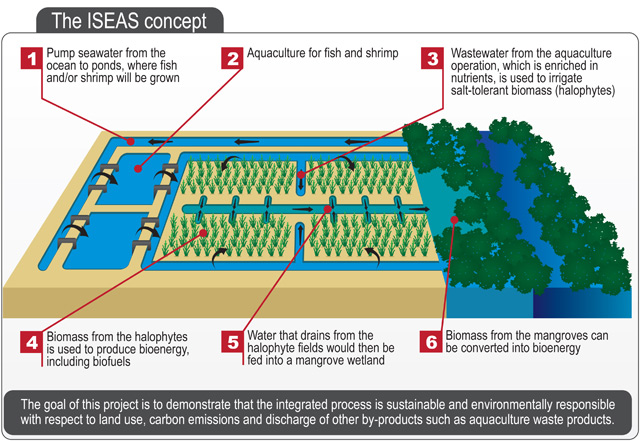Seven years ago, Flight International reported on a seemingly far-fetched concept: the possibility of powering commercial aircraft with biofuel derived from saltwater plants, or halophytes, grown in the desert and irrigated using seawater.
Fast-forward to the present, and Boeing has teamed up with Etihad Airways and Honeywell UOP to make this a reality.
Demonstration flights using an alternative fuel derived from the salt-tolerant salicornia crop, which will be grown in Abu Dhabi and irrigated by wastewater from the Emirate’s growing aquaculture industry, are “feasible” within two to three years, says Boeing Commercial Airplanes managing director for environmental strategy and integration Julie Felgar.
However, a great deal of research lies ahead, and it could be another decade before this type of fuel is ready for use on a wider scale. “We’ve got a process ahead of us. We’re probably talking a five- to 10-year approach, perhaps sooner,” adds Felgar.
The viability of growing salicornia as a feedstock and its potential for commercialisation will be investigated by the Sustainable Bioenergy Research Consortium (SBRC), which is being funded by Boeing, Etihad and Honeywell in association with the Masdar Institute of Science and Technology in Abu Dhabi.
Over the coming year, scientists from the SBRC plan to create a test ecosystem by planting two crops of halophytes which will be nourished by wastewater funnelled from a nearby fish and shrimp farm. Once cleansed by the halophytes, this water will then flow into a field of mangroves before returning to the sea. Both the halophytes and clippings from the mangroves will then be converted into biofuel.
“One of the biomass sources is salicornia, which is salt-tolerant and can be grown in coastal areas without the need for freshwater,” says Etihad chief operations officer Richard Hill. “This would involve an integrated seawater energy agriculture system that combines fish and shrimp farming to provide nutrients to fertilise the salicornia. Such a system could also create green electricity, in addition to biofuel.”
One of the advantages of salicornia is that the entire plant can be used to make biofuel, making it easier to scale up to commercially viable levels. “Initially we thought we could take oil from the seeds and convert it into biofuel,” says Felgar. Upon further research, it transpired that the whole of the plant could be taken apart and converted. “The fact that we can use the whole plant makes scalability more realistic,” she adds.
Etihad’s Hill says there has been “rapid progress” on addressing the all-important scalability question over the last five years. “Our halophytes, with the technology to use all of the plant parts for fuel and other energy sources, make it potentially very viable,” he says. “Of course, there is also potential here in Abu Dhabi and the region to look at other feedstocks, such as waste materials including municipal and agricultural waste.”
Another key advantage – particularly for arid regions such as the United Arab Emirates – is that freshwater, an increasingly scarce resource, is not required for irrigation. As SBRC director Alejandro Rios Galvan puts it: “This project can have a global impact, since 97% of the Earth’s water is ocean and 20% of the Earth’s land is desert.”

Flightglobal/Tim Bicheno-Brown
As a member of the Sustainable Aviation Fuel Users Group, Etihad has committed to driving the market for alternative fuels which follow a strict set of sustainability guidelines, as Hill explains: “Members are required to commit to a sustainability pledge, which includes the development of jet fuel plant sources in a manner that is non-competitive with food, and where cultivation of plant sources should not jeopardise drinking water supplies.
"Therefore, if we are supporting the development of alternative fuel feedstock in water-scarce environments, the use of halophytes is a potential solution.”
Planting for the pilot facility will begin in November, and a larger-scale facility will follow several years later. “We hope within three to four years to move to a 200ha [494 acres] facility and then to a much larger agricultural domain,” says Felgar, stressing that Boeing is “really focused on halophytes”.
While there is “no target” for demonstration flights, Felgar says this is “feasible within two to three years” – something Boeing would never have thought possible until recently. “Five years ago if you had asked any of us would we be where we are today, we would have said no,” she adds.
In order to launch Abu Dhabi’s BIOjet initiative, Etihad carried out a demonstration flight in January using an as-yet uncertificated biofuel produced through the fermentation of plant biomass. The 50min Boeing 777 flight was conducted in Abu Dhabi airspace, with one of the engines running on a 10% blend of biokerosene produced by Total and Amyris. Takreer – a wholly owned subsidiary of Abu Dhabi National Oil Company (ADNOC) – carried out the final aviation biofuel distillation.
The fuel used in the demonstration flight is being evaluated by certificating body ASTM International, and Etihad’s Hill believes the flight “will support the approval process”. The BIOjet Abu Dhabi initiative aims to develop a comprehensive framework for a UAE biofuel supply chain.
“Each of these [BIOjet] partners will play an essential role in developing a commercial aviation biofuel industry in Abu Dhabi, and our combined expertise will help to overcome challenges often faced in the commercialisation of alternative fuel paths,” says Hill. “The next step will be to drive a stakeholder dialogue exercise, to inform and engage a broader group of entities who can contribute to the success of alternative fuel development in Abu Dhabi.”
Boeing's Felgar says Abu Dhabi has “the right list of ingredients” to become a key producer of alternative aviation fuels. Those ingredients include “focused leadership, a significant amount of funding, world-class researchers and a very willing airline customer”.
If halophyte-derived fuels take off, Felgar expects to see a “vertical integration model”, whereby Abu Dhabi exports its knowledge and experience to other arid countries such as “Morocco, South Africa, Australia and certain areas of China”.
Source: Flight International























